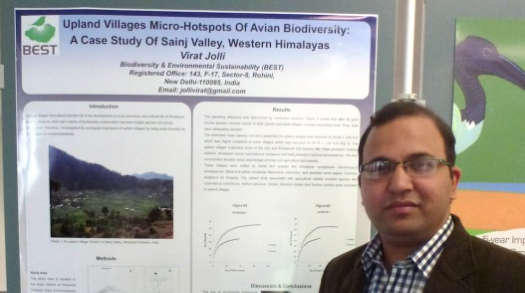A few months back, I was searching literature for information on birds of Chamba, a Western Himalayan town situated in Himachal Pradesh, India, and to my surprise I came across a historical paper written by Major C.H.T. Marshall on “Notes of Birds of Chamba, in the North Western Himalayas” published in 1885, in the Journal IBIS. This paper threw light for the first time on the avian composition and bird species of Chamba. Such records are invaluable for field ornithologists as there is so little information available on the birds of the Himalayas. I was fortunate that I am an Early-career Researcher (ECR) member of the BOU and, as part of my membership, I have access to IBIS and this piece of work. I particularly mention this to let others know how beneficial it can be to be a BOU member.
The BOU is one of the oldest and most respected ornithological organisations and was founded over 150 years ago in 1858. It regularly organises international conferences on different ornithological themes. It was the conference which prompted me to become a member in 2013. In 2014 I had my work accepted for presentation and I attended the BOU’s Upland Birds conference. I’ve since presented my work in 2016 (Urban Birds) and in 2017 (Avian Tracking and Population Processes).
Presenting work at such prestigious BOU conferences is indeed a learning experience, where you get international exposure and a chance to interact with world renowned ornithologists from many different nations. A key advantage of attending BOU conferences is social networking, and making new friends which prove to be beneficial for career advancement. This is especially useful for ECRs. During the conferences, the BOU runs side events organised for ECRs to make them more familiar with things like using social media (Twitter, blogs, Instagram etc.) and how to use them more effectively for their career advancement. I regularly follow tweets of BOU (@IBIS_journal) to update myself about each and every aspect of ornithology
Being an international organisation, the BOU has wide international presence, and sharing your work on the BOU blog will circulate and spread your research to a much wider audience. Moreover, the BOU has strong presence on Twitter which further spreads your view-point, opinion and research findings to people interested in birds.
Currently, I am running an NGO for nature conservation which requires good networking with like-minded people, The BOU has enabled me to gain knowledge and connections which have benefited my organisation. I wish to remain connected with BOU and its community for advancing ornithology in India.
As a developing nation BOU member, I encourage budding ornithologists to join, particularly ECRs, and to be a part of the BOU – it will surely add wings to their thoughts.
More articles by Virat
BOU2017 – a Storify summary of the BOU’s 2017 annual conference
Engaging local communities in conserving habitats of Himalayan birds
In search of the sacred birds of India
And there’s more . . .
This article is part of a series explaining more about what we do and why we do it (see links below). You can also read more about some of our community, about why they are BOU members and why and how they help us deliver our many activities.
More about the BOU
The BOU’s global ornithology community
What does it take to run the #1 ornithology journal?
What makes a BOU conference?
Funding ornithology – the work of the BOU Grants Committee
The BOU – a personal perspective from the US
Listing into the future
BOU – we’re better when we’re together
Developing early-career researchers
Meet some of our members and those who help run the BOU
Blog with #theBOUblog
If you want to write about your research in #theBOUblog, then please see here.



